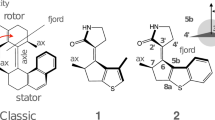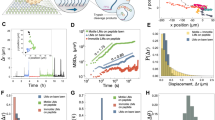Abstract
The design of artificial molecular machines1,2,3,4,5,6,7,8,9,10,11,12,13,14,15,16,17,18,19 often takes inspiration from macroscopic machines13,14,15,16,17,18,19. However, the parallels between the two systems are often only superficial, because most molecular machines are governed by quantum processes. Previously, rotary molecular motors3 powered by light4,5,6 and chemical7,8,9,10,11 energy have been developed. In electrically driven motors, tunnelling electrons from the tip of a scanning tunnelling microscope have been used to drive the rotation of a simple rotor12 in a single direction and to move a four-wheeled molecule across a surface13. Here, we show that a stand-alone molecular motor adsorbed on a gold surface can be made to rotate in a clockwise or anticlockwise direction by selective inelastic electron tunnelling through different subunits of the motor. Our motor is composed of a tripodal stator for vertical positioning, a five-arm rotor for controlled rotations, and a ruthenium atomic ball bearing connecting the static and rotational parts. The directional rotation arises from sawtooth-like rotational potentials, which are solely determined by the internal molecular structure and are independent of the surface adsorption site.
This is a preview of subscription content, access via your institution
Access options
Subscribe to this journal
Receive 12 print issues and online access
$259.00 per year
only $21.58 per issue
Buy this article
- Purchase on Springer Link
- Instant access to full article PDF
Prices may be subject to local taxes which are calculated during checkout




Similar content being viewed by others
References
Bath, J. & Turberfield, A. J. DNA nanomachines. Nature Nanotech. 2, 275–284 (2007).
Goel, A. & Vogel, V. Harnessing biological motors to engineer systems for nanoscale transport and assembly. Nature Nanotech. 8, 465–475 (2008).
Kottas, G. S., Clarke, L. I., Horinek, D. & Michl, J. Artificial molecular rotors. Chem. Rev. 105, 1281–1376 (2005).
Van Delden, R. A. et al. Unidirectional molecular motor on a gold surface. Nature 437, 1337–1340 (2005).
Liu, M., Zentgraf, T., Liu, Y. M., Bartel, G. & Zhang, X. Light-driven nanoscale plasmonic motors. Nature Nanotech. 8, 570–573 (2010).
Ruangsupapichat, N., Pollard, M. M., Harutyunyan, S. R. & Feringa, B. L. Reversing the direction in a light-driven rotary molecular motor. Nature Chem. 3, 53–60 (2011).
Hernandez, J. V., Kay, E. R. & Leigh, D. A. A reversible synthetic rotary molecular motor. Science 306, 1532–1537 (2004).
Kelly, T. R., Silva, R. A., De Silva, H., Jasmin, S. & Zhao, Y. J. A rotationally designed prototype of a molecular motor. J. Am. Chem. Soc. 122, 6935–6949 (2000).
Chen, L., Nakamura, M., Schindler, T. D., Parker, D. & Bryant, Z. Engineering controllable bidirectional molecular motors based on myosin. Nature Nanotech. 7, 252–256 (2012).
Lee, L. K., Ginsburg, M. A., Crovace, C., Donohoe, M. & Stock, D. Structure of the torque ring of the flagellar motor and the molecular basis for the rotational switching. Nature 466, 996–1000 (2010).
Uchihashi, T., Iino, R., Ando, T. & Noji, H. High-speed atomic force microscopy reveals rotary catalysis of rotorless F1-ATPase. Science 333, 755–758 (2011).
Tierney, H. L. et al. Experimental demonstration of a single-molecule electric motor Nature Nanotech. 6, 625–629 (2011).
Kudernac, T. et al. Electrically driven directional motion of a four-wheeled molecule on a metal surface. Nature 479, 208–211 (2011).
Astumian, R. D. Thermodynamics and kinetics of a Brownian motor. Science 276, 917–922 (1997).
Manzano, C. et al. Step-by-step rotation of a molecule-gear mounted on an atomic-scale axis. Nature Mater. 8, 576–579 (2009).
Wickham, S. F. J. et al. Direct observation of stepwise movement of a synthetic molecular transporter. Nature Nanotech. 6, 166–169 (2011).
Shirai, Y., Osgood, A. J., Zhao, Y. M., Kelly, K. F. & Tour, J. M. Directional control in thermally driven single-molecule nanocars. Nano Lett. 5, 2330–2334 (2005).
Vives, G. & Rapenne, G. Directed synthesis of symmetric and dissymmetric molecular motors built around a ruthenium cyclopentadienyl tris(indazolyl)borate complex. Tetrahedron 64, 11462–11468 (2008).
Vives, G., de Rouville, H. P. J., Carella, A., Launay, J. P. & Rapenne, G. Prototypes of molecular motors based on star-shaped organometallic ruthenium complexes. Chem. Soc. Rev. 38, 1551–1561 (2009).
Joachim, C. et al. Multiple atomic scale solid surface interconnects for atom circuits and molecule logic gates. J. Phys. Condens. Matter 22, 084025 (2010).
Stipe, B. C., Razaei, M. A. & Ho, W. Coupling of vibrational excitation to the rotational motion of a single adsorbed molecule. Phys. Rev. Lett. 81, 1263–1266 (1988).
Sainoo, Y., Kim, Y., Komeda, T., Kawai, M. & Shigekawa, H. Observation of cis-2-butene molecule on Pd(110) by cryogenic STM: site determination using tunneling-current-induced rotation. Surf. Sci. 536, L403–L407 (2003).
Henningsen, N. et al. Inducing the rotation of a single phenyl ring with tunneling electrons. J. Phys. Chem. C 111, 14843–14848 (2007).
Wahl, M., Stohr, M., Spillmann, H., Jung, T. A. & Gade, L. H. Rotation–libration in a hierarchic supramolecualr rotor–stator system. Chem. Commun. 13, 1349–1351 (2007).
Tanaka, H. et al. Molecular rotation in self-assembled multidecker porphyrin complexes. ACS Nano 5, 9575–9582 (2011).
Hla, S. W. STM single atom/molecule manipulation and its application to nanoscience and technology. J. Vac. Sci. Technol. B 23, 1351–1360 (2005).
Parschau, M., Passerone, D., Rieder, K.-H., Hug, H. J. & Ernst, K.-H. Switching the chirality of single adsorbate complexes. Angew. Chem. Int. Ed. 48, 4065–4068 (2009).
Iancu, V. & Hla, S. W. Realizing of a four-step molecular switch in scanning tunneling microscope manipulation of single chlorophyll-a molecules. Proc. Natl Acad. Sci. USA 103, 13718–13721 (2006).
Pascual, J. I., Lorente, N., Song, Z., Conrad, H. & Rust, H. P. Selectivity in vibrationally mediated single-molecule chemistry. Nature 423, 525–528 (2003).
Ample, F. & Joachim, C. A semi-empirical study of polyacene molecules adsorbed on a Cu(110) surface. Surf. Sci. 600, 3243–3251 (2006).
Astumian, R. D. & Bier, M. Mechanochemical coupling of the motion of molecular motors to ATP hydrolysis. Bio. Phys. 70, 637–653 (1996).
Ait-Haddou, R. & Herzog, W. Brownian ratchet model of molecular motors. Cell Biochem. Biophys. 38, 191–213 (2003).
Lee, H. & Levitov, L. S. Current fluctuations in a single tunnel junction. Phys. Rev. B 53, 7383–7391 (1996).
Acknowledgements
The authors acknowledge financial support from the AUTOMOL project (ANR 09-NANO-040) for molecular motor synthesis and calculations, the US Department of Energy (BES grant DE-FG-02-02ER46012) for the work of the Ohio University team (U.G.E.P., H.K., Y.Z. and S.-W. H), the A*STAR Atom Tech VIP programme phase III (2011–2014), CNRS and the University Paul Sabatier of Toulouse. G.V. acknowledges the French Ministry of National Education and the Ecole Normale Supérieure of Lyon for a PhD fellowship. The authors also thank I.M. Dixon for comments on the manuscript. This paper is dedicated to the 70th birthday of Karl-Heinz Rieder and to the 60th birthday of François Diederich.
Author information
Authors and Affiliations
Contributions
S.W.H., C.J. and G.R. conceived and designed the research project. U.G.E.P., H.K. and Y.Z performed the STM experiments. F.A., M.G. and C.J. performed calculations. J.E. and C.J. developed the theory. G.V. and G.R. synthesized the molecules. All authors discussed the results and commented on the manuscript.
Corresponding authors
Ethics declarations
Competing interests
The authors declare no competing financial interests.
Supplementary information
Supplementary information
Supplementary information (PDF 1081 kb)
Supplementary movie S1
Supplementary movie S1 (AVI 4120 kb)
Supplementary movie S2
Supplementary movie S2 (AVI 5812 kb)
Rights and permissions
About this article
Cite this article
Perera, U., Ample, F., Kersell, H. et al. Controlled clockwise and anticlockwise rotational switching of a molecular motor. Nature Nanotech 8, 46–51 (2013). https://doi.org/10.1038/nnano.2012.218
Received:
Accepted:
Published:
Issue Date:
DOI: https://doi.org/10.1038/nnano.2012.218
This article is cited by
-
STM studies for surface-mounted molecular rotors: a mini review
AAPPS Bulletin (2024)
-
An electric molecular motor
Nature (2023)
-
An artificial molecular motor powered by electricity
Nature (2023)
-
Atomic-scale visualization of chiral charge density wave superlattices and their reversible switching
Nature Communications (2022)
-
Atomically precise control of rotational dynamics in charged rare-earth complexes on a metal surface
Nature Communications (2022)



